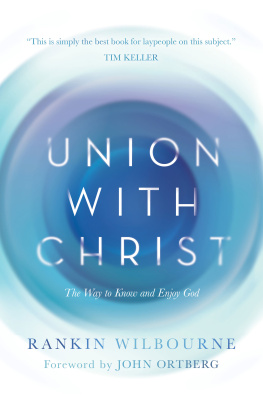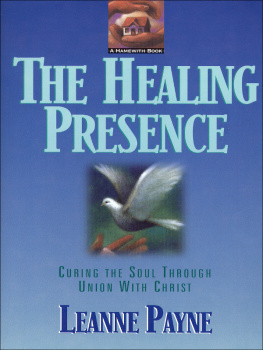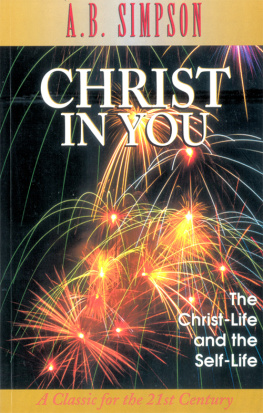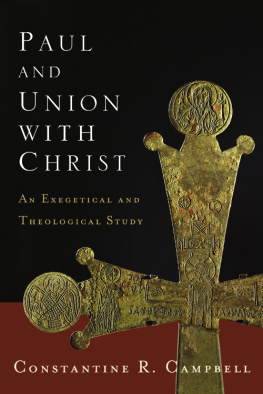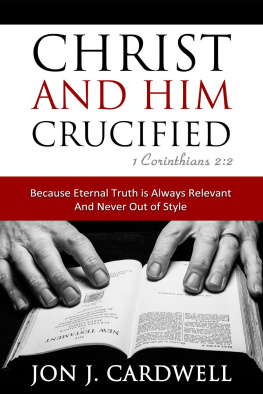Union with Christ
Everyone seems to agree that union with Christ is a biblical teaching crucial to understanding and communicating the gospel, but preachers today do not give it the same emphasis that the New Testament does. One reason is that, unlike the new birth, justification, and adoption, it requires multiple metaphors to draw out its rich meaning. Rankin does so clearly and compellingly. This is simply the best book for laypeople on this subject. It is grounded in exegesis and theology and yet is lucid and supremely practical. While not unaware of the recent controversies about union and justification, which are briefly sketched in the endnotes, Rankins whole concern is to make the biblical teaching accessible and applicable to the reader. He does this with excellence.
Tim Keller, senior pastor of Redeemer Presbyterian Church, New York City
UNION WITH CHRIST
Published by David C Cook
4050 Lee Vance View
Colorado Springs, CO 80918 U.S.A.
David C Cook U.K., Kingsway Communications
Eastbourne, East Sussex BN23 6NT, England
The graphic circle C logo is a registered trademark of David C Cook.
All rights reserved. Except for brief excerpts for review purposes,
no part of this book may be reproduced or used in any form
without written permission from the publisher.
The website addresses recommended throughout this book are offered as a resource to you. These websites are not intended in any way to be or imply an endorsement on the part of David C Cook, nor do we vouch for their content.
Unless otherwise noted, all Scripture quotations are taken from the ESV Bible (The Holy Bible, English Standard Version), copyright 2001 by Crossway, a publishing ministry of Good News Publishers. Used by permission. All rights reserved. Scripture quotations marked KJV are taken from King James Version of the Bible. (Public Domain); NET are taken from NET Bible copyright 19962006 by Biblical Studies Press, LLC. http://netbible.com All rights reserved; NIV are taken from the Holy Bible, NEW INTERNATIONAL VERSION, NIV. Copyright 1973, 2011 by Biblica, Inc. Used by permission. All rights reserved worldwide. NEW INTERNATIONAL VERSION and NIV are registered trademarks of Biblica, Inc. Use of either trademark for the offering of goods or services requires the prior written consent of Biblica, Inc.; NLT are taken from the Holy Bible , New Living Translation, copyright 1996, 2007 by Tyndale House Foundation. Used by permission of Tyndale House Publishers, Inc., Carol Stream, Illinois 60188. All rights reserved; and NRSV are taken from the New Revised Standard Version Bible, copyright 1989, Division of Christian Education of the National Council of the Churches of Christ in the United States of America. Used by permission. All rights reserved. The author has added italics to Scripture quotations for emphasis.
LCCN 2016938482
ISBN 978-1-4347-0938-7
eISBN 978-1-4347-1087-1
2016 J. Rankin Wilbourne
The Team: Tim Peterson, Keith Jones, Amy Konyndyk, Jack Campbell, Susan Murdock
Cover Design: Nick Lee
Printed in the United States of America
First Edition 2016
1 2 3 4 5 6 7 8 9 10
042516
To Morgen, my Beatrice
I now see clearly that our intellect
cannot be satisfied until that truth enlighten it
beyond whose boundary no further truth extends.
In that truth, like a wild beast in its den, it rests
once it has made its way thereand it can do that,
or else its every wish would be in vain.
Dante, Paradiso IV:124129
CONTENTS
Foreword
Im trying to remember the last time I was more excited about a new book or a new author.
Rankin Wilbourne brings a remarkable flair for writing, and a great breadth and depth of learning, and a passionate heart, to the most important subject in the world: What is the true and sufficient destiny for human life?
Those of us who call ourselves Christians know that the answer to this question, somehow, is wrapped up in the gospel. But the word gospel itself has become fuzzy and debated and truncated and partially buried under the distortions and misreadings that are an inevitable part of human history.
One clue to recovering the gospel lies in comparing the way we describe ourselves with the language of the New Testament itself. The word Christian is found only three times. However, the New Testament letters associated with the apostle Paul use the phrase in Christ around 165 times.
Perhaps one of the greatest barriers to faith is not the things we dont know but the things we think we know yet were wrong about. We think of heaven as the pleasure factory rather than life with God. We think of salvation as being able to avoid pain rather than being made right. We think of the gospel as the minimal entrance requirements for getting into heaven rather than the announcement that life with God is now possible on earth through Jesus. We think of faith as what were supposed to believe rather than the mental map about how things are that we carry with us and inevitably live from. We think of Christians as people who have got the heaven job done, while we think of discipleship as optional extra-credit work for spiritual overachievers.
All of this is what Rankin addresses so clearly and compellingly in this book. He combines a rich knowledge and appreciation of historical theology with a penetrating analysis of how God brings about transformation in embodied and largely habit-driven creatures. He does this by unearthing a notion that was central to the early followers of Jesus but has become largely lost in our day: union with Christ.
Life consists in the ability to connect with and draw nourishment from its surroundings. A seed is planted in the ground and would otherwise die except that something whispers to the seed to put out roots and give birth to a stalk, and life happens. A branch is alive only when it is united to a vine.
Human beings were created to live in what Dallas Willard called reciprocal rootedness. We are made to be alive spiritually. This is evident to any objective observer regardless of what they think about God or religion. But it means we require a transcendent connection through which the inner unseen personmind and willcan be nourished and sustained. Apart from this we wither. With this we flourish.
And this is Christ.
This is union with Christ.
It is our salvation. Salvation is not mostly a matter of relocation; it is a matter of transformation. It does not consist primarily of ending up in the right place, but being made into the right person. And this happens when we are immersed in Jesus the way a dolphin is immersed in the ocean, when we are united to Jesus (though more deeply and more profoundly) like a bride is united to her groom.
With this understanding of union with Christ, discipleship suddenly takes its proper place. Its not extra-credit work to earn something. Its the means by which we experience union with Christ more fully and deeply. If we want Christ, we will want to be disciples. If we dont want discipleship, then we might desire to avoid pain, but thats not the same object as desiring Christ.
All of this unfolds with clarity and grace in the pages to follow. Rankin does a masterful job of articulating what union with Christ consists of, how central it was to the writers of Scripture and to great thinkers through the centuries, why it has been lost in our day, and most importantly how to pursue it as a concrete reality in daily life for ordinary people.

